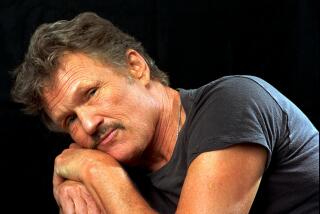Eleanor Creekmore Dickinson, Beat-era artist who explored Pentecostal revivals, dies at 86
Every year, Eleanor Creekmore Dickinson would wash the black and white stripes from her hair and scrub out the electric blue and pink streaks that helped define her as another rebellious San Francisco artist.
She would dye her hair back to its native brown, tone down her dress and return to the Deep South, where she was raised, to carefully capture — on canvas, on black velvet, on videotape — the rituals of Pentecostal revivals.
Her body of work, which stretched from the arresting images of worshipers in revival halls to artifacts such as a snake box, signs urging repentance and a pickle jar with strychnine that true believers might drink, became so authoritative that it was housed at the Smithsonian and displayed in museums from Tennessee to the Bay Area.
Dickinson’s art and relics from the Pentecostal revivals sought to humanize the raw emotions of religion, not to make a spectacle of what might seem strange and extreme to others, a critic with the Knoxville News Sentinel observed in 2005.
“I just don’t judge people,” Dickinson said.
A California artist whose work was nationally recognized, won awards and drew admirers for its far-flung mediums and provocative themes, Dickinson died Feb. 25, days after her 86th birthday.
Dickinson used video, Lucite, scraps of metal and skywriting in her art, even finding an alluring darkness in using black velvet — a material more commonly seen bearing the likeness of Elvis at swap meets and county fairs — as a canvas.
She also believed that viewing art should not necessarily be a comfortable experience.
The largest piece of work she kept in her San Francisco living room was her drawing of an Iraqi man being tortured by U.S. soldiers at the Abu Ghraib prison. A painting she displayed at her studio depicted a rape so violent that she cautioned people to think twice before viewing it. It was meant as a statement about the blame society sometimes puts on victims, she said.
“I’m not doing this to be shocking,” she told the San Francisco Chronicle in 1997. “But good art is shocking.”
Born Feb. 7, 1931, in Knoxville, Tenn., Dickinson exuded the South as a youth — a Southern Baptist; a member of the Daughters of the Confederacy; summer vacations at a cabin in an old logging camp in the Great Smoky Mountains.
In the Bay Area, where she did her graduate work at San Francisco Art Institute and the California College of the Arts, Dickinson arrived just as a bohemian spirit was flourishing. She joined protest marches, turned up the loudness of her appearance and became a player in the art scene. She ran with famed Beat poet Allen Ginsberg and produced a poster of verse and art with Lawrence Ferlinghetti.
She even illustrated a cookbook — “The Complete Fruit Cookbook” — that was deemed obscene in several states because of the curious way lemons and bananas were arranged in an illustration.
But nearly every year, she retreated homeward to continue her documentation of the Pentecostal revivals, watching snake handlers, people who drank poison to prove good would outmuscle evil and those who spoke in tongues until they seemed to reach a state of religious euphoria.
Over the course of her life, the Pentecostal collection and her other works were displayed at the Smithsonian, the Library of Congress’ Archive of Folk Culture, the San Francisco Museum of Modern Art, the Peninsula Museum of Art and the Huntington Library in San Marino, among others. She was named a professor emerita by the California College of the Arts, where she had taught for more than 30 years.
She is survived by a sister, Louise Creekmore Senatore; three children, Peter Dickinson, Katy Dickinson and Mark Dickinson; and six grandchildren, Daniel, Lynda, Forrest, Corey, Paul and Jessica. She was predeceased by her husband Wade.
Twitter: @stephenmarble
More to Read
Start your day right
Sign up for Essential California for the L.A. Times biggest news, features and recommendations in your inbox six days a week.
You may occasionally receive promotional content from the Los Angeles Times.





